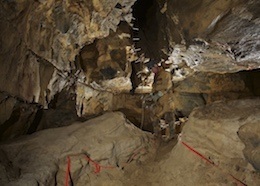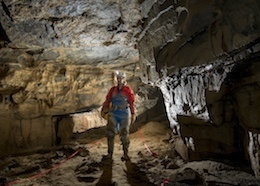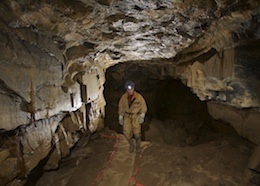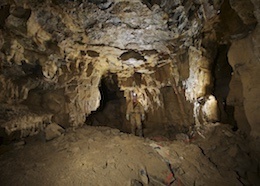Overview
Ogof Dan Y Lleuad Wen is a fossil cave of impressive proportions, with most passages ending in chokes in the Upper Series. In the lower sections of the cave the passages become narrower and rifty, all becoming too small for further progress. Length 450m
Altitude 571m
Grid SN 75794 18665
History
Mark Withers scoured Foel Fraith for draughting shakeholes in the summer of 1991. Finding a strongly blowing hole on the north flank of hill he commenced digging, and after six weeks of almost solo excavation he gained entry to a low passage and open cave. Most of the cave was explored over the following weeks. The final major extension was made by John Drury with help from Liam Keally and Adrian Thomas when a climb down a rift at the bottom of the entrance pitch led to large passages, a chamber and rift passages leading off. Walks back over the mountain during the digging trips were often undertaken by moonlight and so the cave was named 'Under the White Moon - Dan Y Lleuad Wen'.
Location
The cave is located on the northeastern flank of Foel Fraith, and is located in a very small shallow shakehole. A GPS using the above coordinates is the best way to find the entrance, and will also help on the return journey in poor visibility.Black Mountain Central Google map showing the location of Ogof Dan Y Lleuad Wen and other caves in the area.
Location map - click marker to show entrance photo
Access
There are no access restrictions on the cave. The cave is best accessed from Herbert's Quarry some 2.5km away from the cave which will take about 45 minutes to walk across from the car park, assuming you have no great navigational difficulties.
Description
In the bottom of the shakehole a 4 m climb down through rocks leads into a comfortable crawling passage. To the right the crawl chokes after a short distance, while the way on is to the left. This passes a stalagmite in the middle of the passage and then quickly develops into a taller keyhole profile which can be walked along to reach the a boulder covered balcony overlooking the first pitch. A set of four hangers are in place on the right hand wall to allow you to rig the 10 m pitch as a free-hang. The pitch drops onto an enormous pile of large bouders after 7 m, from where the final 3 m climb down leads into the bottom of a large section of passage - Debbie’s Dread. At the bottom of the pitch the passage reaches a wet and dripping choke after 20 m which must lead up to an adjacent shakehole on the surface. Below the pitch a climb down through boulders leads to Lon Drury.Lon Drury
Below the pile of large boulders at the foot of the entrance pitch is a route to an 8 m climb down into a rift - Lon Drury. This gives access to a rift passage below the entrance passage which is up to 11 m high and 3 wide. This leads for 15 m to a crossroads. Left closes down, straight on goes back into boulders, and a squeeze to the right gains a narrow, descending rift followed for 10 m to a boulder blockage. Here, going up, a passage on the left behind the boulders can be found, and a larger rift is reached. A short climb leads to a tube and small chamber - Siambra Cwmamman. The tight rift continues for 7 m until no further progress can be made.
The Upper Series
The obvious way on is to the left of the first pitch and almost immediately another passage is seen going off to the left. This is Mark’s Grotto, a short climb leads up to this taped-off passage which contains some nice formations but there is no way on. Continuing along the main passage, which runs up dip, the boulders reach the roof and the way on is via an obvious passage to the right. Here there is a 3 m climb down over boulders and care should be taken as some of the boulders move! A handline is in place to assist on the bottom section of the overhanging climb. The passage reduces in size to around 3 m high and 2 m wide with a sandy floor and mud formations. After passing a couple of low level passages on the right that choke quickly a junction is met at a rock pillar. This marks the start of a loop route with the direct way on the right and a longer oxbow on the left. Taking the left passage leads past a low passage on the left that soon chokes and then past an area of shattered wall. A right hand bend then leads into better formed passage which dog-legs left and then right past a run-in choke and then down under a large boulder on a right hand corner. A tall section of passage with a short traverse over a hole then brings you to a T-junction. To the right 30 m of tall narrow rift leads back to the rock pillar and start of the oxbow. Just before the rock pillar is reached a descending rift located 1 m up in the right hand wall can be descended to reach the Lower Series. At the junction at the end of the oxbow, the passage continues very large for 15 m due south to reach a 3 m sheer drop overlooking a large chamber. Keeping to the left an easy traverse misses most of the climb down. The chamber is 30 m long and 6 m wide with water entering from the choke on the right. There are areas of formations in the roof and a fine mud floor with stalagmites is taped off on the left hand side of the passage. At the end of this chamber a sharp left turn reaches the start of The Canyon - a 20 m tall and 3 m wide section of passage. The floor drops down and then rises to reach an area of boulder collapse. Here a vaulted aven with a flat roof is reached, where water showers down. A climb up boulders at the back wall allows you to reach the top of a magnificent rock bridge with a commanding view back down the passage.
The Lower Series
A few metres beyond the rock pillar a descending rift is entered on the left hand side of the passage - A Day Out At The Beach. This descends steeply and turns a corner to reach the top of a 3 m drop directly down into a wide passage below. A short ladder is needed for this descent, a hanger is in place and natural threads are available further back. The passage is covered with impressive sand banks of very light coloured laminated sands. Going left from the bottom of the climb passes a taped-off oxbow on the right before reaching a large choke ahead, just before which is a passage on the left that can be followed for about 30 m before it chokes. Going right from the bottom of the ladder descends past sand banks to reach a junction on the left, this reaches a T-junction, the left branch being the other side of the taped oxbow, while right becomes a tall rift. This has a very awkward squeeze before an ascent up boulders reaches a T-junction. Right leads to a descending rift with a 3 m roped climb down to a boulder choke with a view down to a streamway, too tight to enter. Left at the T-junction leads to a tall rift and over some impenetrable slots in the floor to reach a climb up to a high level tube. This heads north for about 10 m before becoming too tight. Back in the rift, it ends at a steep tight sandy dig to enter the base of a sand and giant rock filled aven. Back at the T-junction a 3 m climb up reaches a high level passage that continues south to enter a wet choke. This can be followed for a short distance, the choke is below the large chamber in the Upper Series. Following the passage south from the entrance ladder reaches a large choke, where a way through leads to short section of passage before that too chokes. About 15 m before the choke a passage is seen on the right which is a descending rift that leads after 20 m to the top of a 15 m deep vertical tube. This can be laddered or carefully climbed down to reach a small stream which chokes quickly in both directions.
Tackle
Pitch 1 - Debbie’s Dread - 10m ladder and lifeline (bottom 3m free climbable) | Belay from 4 hangers Pitch 2 - To Lower Series - 3m of ladder and lifeline | Belay from 1 hanger + natural thread
Pitch 3 - Dark Side of the Moon - 15m ladder and lifeline | Belay from natural thread
References
Cambrian Cave Registry for Ogof Dan Y Lleuad Wen Descent | No.102 p12 (1991) | No.104 p34 (1992) | No.113 p10 (1993) | No.136 p9 (1997)
Caves of South Wales | Tim Stratford | p116 (1995) | ISBN: 1-871890-03-9 | Published by Cordee
South Wales C. C. Newsletters | No.114 p7 (1994) | No.115 p7 (1995)
Y Ddraig Goch | No.20 pp102-110 (1993)
Caves and Caving | No.54 p20 (1991) | No.55 p28 (1992) | No.60 p6 (1993)
Isca C.C. Journal | No.1 Vol.14 p3
Caves of Carmarthen | Tony Oldham
Warnings
There are areas of loose rock in this cave. The 3m climb down on the route beyond the entrance pitch has loose rocks, the handline in place should avoid reliance on the loose rocks. The climb down the rift at the start of Lon Drury contains much loose rock, take care as you climb down.
Disclaimer
The photographs and information of this page has been provided to help cavers planning trips. Caving can be a dangerous activity, if you are interested in exploring caves please join a caving club so you can enjoy a safe introduction to this sport. Local caving clubs are listed on the links page or you can visit the 'New To Caving' website for more options.If you feel that any of the information is incorrect or should be updated please contact us.








